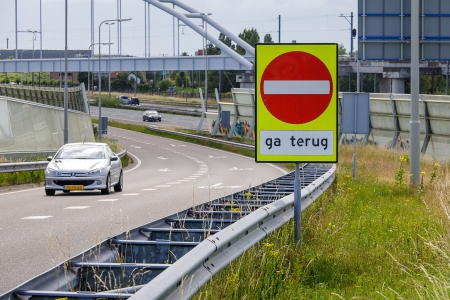Where?
Most wrong-way driving crashes occur on motorways, but this is inherent in the definition that indicates separate lanes are an essential criterion. Entering the motorway via the exit ramp and turning on the motorway are the two most common scenarios that lead to wrong-way driving [2] [5] [15]. Xing [16] also mentions taking a wrong turn-off from a parking area: 12% of wrong-way driving crashes in Japan. In Germany, however, this percentage is much lower (1.5% [5]).
A recent study of police files on Dutch wrong-way driving crashes and incidents [1], although probably not entirely representative, shows that most wrong-way driving crashes and incidents occur on the main carriageway. Of the 68 incidents analysed, 45 occurred on the main carriageway (of which 34 occurred in the leftmost lane, or the rightmost lane for the wrong-way driver), 6 on an entry or exit ramp, and 3 in the emergency lane). For 14 incidents, the location was unknown. Wrong-way driving crashes on the main carriageway result in significantly more serious injuries than crashes occurring on the entry/exit ramp. For example, Doctor [15] reports that in the United States, 42% of wrong-way driving crashes on the main carriageway result in fatal or serious injuries; for wrong-way driving crashes on the entry/exit ramp this is 6%.
When?
Most wrong-way driving crashes occur in the evening, at night and in the early morning. In the Netherlands, between 1983 and 1998, this was the case in over 65% of wrong-way driving crashes [2]. Partly related to this: most wrong-way driving crashes/incidents take place in the dark. In the study of the police files on 68 wrong-way driving crashes/incidents in the period 2015-2019 [1], it was dark or dusky, either with or without street lights, in 51 cases, and only in 17 cases it was light.
International research also shows that relatively many crashes occur in the evening and at night, and particularly on weekend nights. On French motorways, 50 to 60% of wrong-way driving crashes occur at night [7]. In the United States, over 75% of crashes occur between 6 pm and 6 am [8]. Zhou et al. [10] report that in the state of Illinois, 51% of wrong-way driving crashes occur between midnight and 5 a.m. and 43% occur on weekend nights. Also based on data from the United States, Doctor [15] indicates that 31% of wrong-way driving crashes occur between midnight and 3 a.m. and 57% occur on weekend nights. On the basis of Swiss data, Scaramuzza and Cavegn [6] report that the risk of a wrong-way driving crash is almost twice as high when it is dark.
